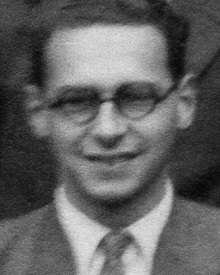Egil Hylleraas
Egil Andersen Hylleraas (May 15, 1898 – October 28, 1965) was a distinguished Norwegian theoretical physicist known for his simple but elegant method for predicting the ground state energy of two-electron atoms as well as trial wave functions for many-electron atoms.
Egil Andersen Hylleraas | |
|---|---|
 1934 at London | |
| Born | May 15, 1898 |
| Died | October 28, 1965 (aged 67) |
| Nationality | Norwegian |
| Alma mater | University of Oslo |
| Known for | Hylleraas co-ordinates Hylleraas CI |
| Scientific career | |
| Fields | Theoretical Physics |
| Institutions | Christian Michelson Institute, Bergen University of Oslo |
Early life and education
Hylleraas, the name of the farm where he was born, was the son of Ole Andersen, a teacher in the mountain village of Engerdal in southern Norway. Hylleraas was the youngest of eleven children. After elementary school he stayed home, performing duties such as chopping timber or watching the cattle up in the mountains during the summer. Only at the age of seventeen did he attend high-school and three years later he started studies at the University of Oslo. Upon leaving University he became a teacher who could not forget the many interesting problems he had learned about. Upon reading a book by Max Born, on crystal lattices, he started calculations on double refraction of light. Publications of this work provided him with a Fellowship from the International Education Board which he used to go and work with Max Born at the University of Göttingen in 1926–28.
The Golden Age of Atomic Physics
In his Reminiscences,[1] Hylleraas referred to the period 1925–1930 as the Golden Age of atomic physics. It was a time when Bohr's theory of the atom was being replaced by the new quantum mechanics. By 1926, the one-electron hydrogen problem had been solved and Heisenberg had formulated the two-electron helium problem quantum mechanically but a simple first-order perturbation treatment yielded an ionization potential considerably in error with experimental measurement.[2] Born considered it crucial for quantum mechanics to provide a result in much better agreement with experiment.
When Hylleraas arrived in Göttingen he was disappointed to learn that Born had abandoned crystallography. At first, he continued his work on crystals on his own but when Bohr's student became ill, he was assigned the urgent task of working on the helium problem. Hylleraas modified the first attempt in two important ways: he replaced the incomplete bound-state hydrogenic functions by the complete Laguerre functions and reduced the number of co-ordinates from 6 to 3, namely the distances of the two electrons from the nucleus and the angle between the position vectors of the two electrons. Then, with the aid of a mechanical desk calculator obtained result in much better agreement with experiment. The result was well received but the discrepancy of 0.12 eV continued to bother him. Later in 1928, a breakthrough was achieved when he realized the angle co-ordinate should be replaced by the distance between the two electrons. With only three terms in the wave function expansion, the error had been reduced to 0.03 eV, with six terms to 0.01 eV. His work was quickly applied to other two-electron atoms and to the hydrogen molecule.
Hylleraas was one of the founding fathers of CERN and represented Norway to the European Council for Nuclear Research,[3] which later led into the establishment of the organization itself.
Awards
- Gunnerus Medal (1960)[4]
See also
- Two-electron atom
- Hylleraas co-ordinates
- Hylleraas configuration interaction (Hy-CI or H-CI)
Notes
- Hylleraas, Egil A. (1963). "Reminiscences from Early Quantum Mechanics of Two-Electron Atoms in the Proceedings of the International Symposium on Atomic and Molecular Quantum Mechanics in Honor of Egil A. Hylleraas". Reviews of Modern Physics. 35: 421–431. Bibcode:1963RvMP...35..421H. doi:10.1103/revmodphys.35.421.
- Helgaker, Trygve; Klopper, Wim (2000). "Perspective on "Neue Berechnung der Energie des Heliums im Grundzustande, sowie des tiefsten Terms von Ortho-Helium" (the title of Hylleraas' first publication)". Theoretical Chemistry Accounts. Springer Verlag. 103: 180–181. doi:10.1007/s002149900051.
- 2nd Session of the European Council for Nuclear Research : Minutes of the session (Report). CERN. October 15, 1952. CERN/GEN/2. Retrieved September 20, 2017.
- "Innehavere av Gunnerusmedaljen". Det Kongelige Norske Videnskabers Selskab. Archived from the original on May 21, 2012. Retrieved May 6, 2015.
External links
| Wikimedia Commons has media related to Egil Hylleraas. |
- Hylleraas, Egil Andersen Scientific Biography
- Superraske datamaskiner bruker Egil Hylleraas matematiske metoder [Superfast computers use Hylleraas mathematical methods]